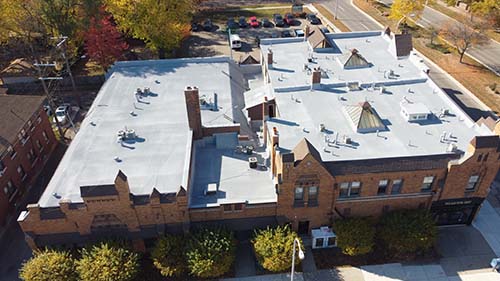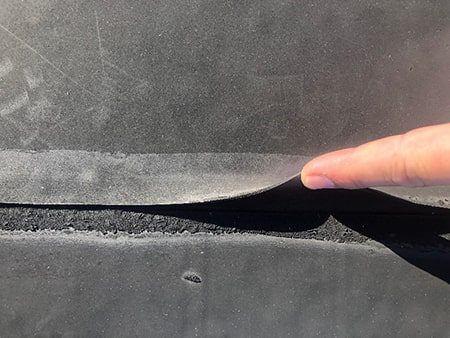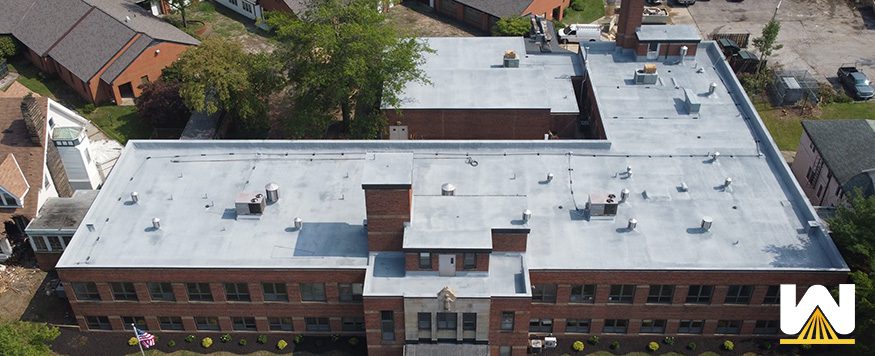Here are the 7 advantages of spray foam roofing:
- High R-value
- Renewable
- Quickly installed
- Self-flashing
- Seamless
- Easy to maintain
- Proven since the 1960s
Spray foam roofs have a high R-value
Spray foam has the highest R-value of any commonly used roof insulation. Here are the average R-values for some common roof materials
- Spray Foam: 6.6 per inch
- Metal: 0.00 per inch
- BUR Gravel: 0.34 per inch
- BUR Smooth: 0.24 per inch
- XPS Insulation: 5.0 per inch
- EPS Insulation: 3.85 per inch
- Polyiso: 5.5 per inch
R value is the capacity of an insulating material to resist heat flow. The higher the R-value, the greater the insulating power.
The higher the R value, the less heat or cool air that will pass through. Higher R value = less HVAC use = lower energy costs
Total payback of your new roof usually occurs in less than ten years through savings in heating and cooling costs.

Spray foam roofs are renewable
One of the benefits of a spray foam roof is its ability to be re-coated.
A properly installed and maintained spray foam roof should not require re-coating for 10 to 20 years. The best way to determine when a spray foam roof needs to be re-coated is to measure the remaining coating thickness on the roof and recoat before the coating is too thin to provide U.V. protection.
The first application of the coating is usually applied at a thickness of 20-30 mils.
After 10 years, the coating could be reduced to a thickness of 7-10 mils, depending on the wear of the roof.
Many coating manufacturers offer extended warranties with each re-coat. This option, along with scheduled maintenance, allows a spray foam roof to be a truly renewable roof system.
Spray foam roofs are quickly installed
Spray foam roofs are installed quicker than other roofing systems, due to:
- Most SPF roofing projects involve little to no tear off
- Spray foam roofs are spray-applied, meaning they can go around penetrations with ease
- Spray foam roofs require less material and equipment than traditional roofing systems
Because spray foam is quickly installed, business interruption and labor costs are minimized.
Spray foam roofs are self-flashing
Self-flashing refers to spray foam’s ability to conform to irregular shapes. Watch the video below which shows spray foam being sprayed around a curb:
In the video, it says “It might take a conventional roofer 30 minutes to flash around a curb, spray foam can be applied in about two minutes”.
Other roofing systems, like rubber, will need to be custom cut in order to be installed properly around a curb.
Self-flashing allows spray foam to be applied faster around all penetrations, including:
- Parapet walls
- Vents
- Pipes
- HVAC units
- Skylights
- Drains
Spray foam is seamless
A big advantage spray foam has over other roofing systems is that it’s seamless.
Being seamless, and therefore monolithic and watertight, avoids traditional single-ply membrane seams that tend to be the sources of leaks.

How do leaks form on a rubber roof?
Seams start to separate over time and allow water to get inside. Also, they can allow some water to get in, it freezes, and when it thaws out, it breaks apart the seam even more.
Wind uplift is also an issue with seams. Wind will eventually get underneath a slightly separated seam, loosen and eventually allow an opportunity for water to enter the building.
Spray foam roofs are easy to maintain
Perhaps a sharp tool has been dropped, or the HVAC guy planted the HVAC panels in your roof like a javelin.
In order to fix these minor repairs, all you’ll need is a utility knife and some caulk.
- Step 1: cut out the defective area
- Step 2: dry the area out
- Step 3: apply caulk and smooth
That’s it. Minor repairs can be done by in-house maintenance staff.
Spray foam is proven to be beneficial
Since the early 1960s, spray foam roofs have been installed and recoated, strengthening the popular phrase “A spray foam roof is the last roof you’ll ever have to install”.
Multiple roofs that have been installed decades ago are going on their 2nd or 3rd recoat.
In fact, our first example, Brian Chavalia (now in sales and ownership of West Roofing Systems, Inc.), was the master sprayer on a job he did 27 years ago. Now he’s going back for a recoat. Check out the video on Central Village below:
Central Village Apartments in Amherst, Ohio
Initially Installed: 1992
Number of recoats: 2
Playhouse Square in Cleveland, Ohio
Initially installed: 1972
Number of recoats: 3
Sandusky Schools in Sandusky, Ohio
Initially installed: 1980
Number of recoats: 3
Conclusion on spray foam advantages
Spray foam roofs are installed quickly, resulting in a lower labor cost and less interruption. When considering the many variables in a re-roofing project, the versatility of a foam roof makes it a logical and cost-effective solution.


